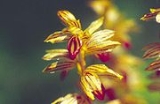
Corallorhiza striata
Encyclopedia
Corallorhiza striata is a species of orchid
known by the common names striped coralroot and hooded coralroot. This flowering plant is native to much of North America, especially Canada and the northern and western United States. It is a member of the coniferous understory flora, where it lives in the layer of decaying plant matter on the ground obtaining nutrients from fungi via mycoheterotrophy
.
, it has reduced leaves and no chlorophyll
and relies upon its parasitism of the fungi for sustenance. This coralroot has an erect stem which may be red, pink, purple, or yellow-green to almost white. It is mostly made up of an inflorescence
of orchid flowers. Each flower is an open array of sepal
s and similar-looking petals which may be pink or yellowish and have darker pink or maroon stripes. Inside the flower is a column formed from the fusion of male and female parts, which may be spotted with purple or red. The fruit is a capsule one or two centimeters long.
Orchidaceae
The Orchidaceae, commonly referred to as the orchid family, is a morphologically diverse and widespread family of monocots in the order Asparagales. Along with the Asteraceae, it is one of the two largest families of flowering plants, with between 21,950 and 26,049 currently accepted species,...
known by the common names striped coralroot and hooded coralroot. This flowering plant is native to much of North America, especially Canada and the northern and western United States. It is a member of the coniferous understory flora, where it lives in the layer of decaying plant matter on the ground obtaining nutrients from fungi via mycoheterotrophy
Myco-heterotrophy
Myco-heterotrophy is a symbiotic relationship between certain kinds of plants and fungi, in which the plant gets all or part of its food from parasitism upon fungi rather than from photosynthesis. A myco-heterotroph is the parasitic plant partner in this relationship...
.
Description
Like other coralroot orchidsCorallorrhiza
Corallorhiza, the coralroot orchids, is a genus of flowers in the orchid family. Most species are leafless, relying entirely upon symbiotic fungi within their coral-shaped roots for sustenance...
, it has reduced leaves and no chlorophyll
Chlorophyll
Chlorophyll is a green pigment found in almost all plants, algae, and cyanobacteria. Its name is derived from the Greek words χλωρος, chloros and φύλλον, phyllon . Chlorophyll is an extremely important biomolecule, critical in photosynthesis, which allows plants to obtain energy from light...
and relies upon its parasitism of the fungi for sustenance. This coralroot has an erect stem which may be red, pink, purple, or yellow-green to almost white. It is mostly made up of an inflorescence
Inflorescence
An inflorescence is a group or cluster of flowers arranged on a stem that is composed of a main branch or a complicated arrangement of branches. Strictly, it is the part of the shoot of seed plants where flowers are formed and which is accordingly modified...
of orchid flowers. Each flower is an open array of sepal
Sepal
A sepal is a part of the flower of angiosperms . Collectively the sepals form the calyx, which is the outermost whorl of parts that form a flower. Usually green, sepals have the typical function of protecting the petals when the flower is in bud...
s and similar-looking petals which may be pink or yellowish and have darker pink or maroon stripes. Inside the flower is a column formed from the fusion of male and female parts, which may be spotted with purple or red. The fruit is a capsule one or two centimeters long.

